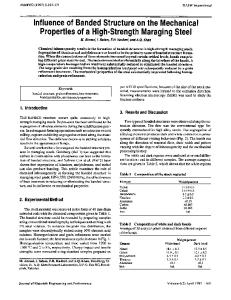Evolution of microstructure and mechanical properties of a new high strength steel containing Ce element
- PDF / 1,130,304 Bytes
- 10 Pages / 584.957 x 782.986 pts Page_size
- 30 Downloads / 384 Views
In the present work, the evolution of microstructure and mechanical properties of high-strength low-alloy D6AC steel containing the Ce element was synthetically investigated by means of electron backscatter diffraction, scanning electron microscope, Transmission electron microscope, and tensile and impact tests. The experimental results show that adding a certain amount of Ce into HSLA-D6AC steel can refine grains and martensite laths, as well as increase the fine VC precipitates, which not only enhance the strength of the steel but also improve the toughness and plasticity. Meanwhile, the morphology of martensite in HSLA-D6AC steel changes from twin martensite to dislocation martensite. It is found that after adding Ce, HSLA-D6AC steel exhibits a distinct necking stage in the tensile test, and the impact toughness value increases from 83 to 136 J. With the appearance of some more and deeper homogeneous dimples, the quasi-cleavage fracture transforms into a ductile fracture characterized by microvoid coalescence, demonstrating that HSLA-D6AC steel with the Ce element achieves excellent comprehensive mechanical properties.
I. INTRODUCTION
High-strength steels have been used increasingly in recent years for critical aircraft and aerospace structural applications. In such applications, though material performance is of prime consideration, cost and availability make the low-alloy steels an attractive option. The lowalloy steels are the most widely used, studied, and discussed steels due to their inherent high strength and toughness combination and suitability and adaptability in many structural applications. HSLA-D6AC steel1 belongs to the high-strength low-alloy steel system, which is a low-alloy vacuum-melted steel containing several elements and a carbon content of 0.42–0.48% with a tensile strength of 1800–2000 Mpa. HSLA-D6AC steel has been in existence for many years and is being used in aircraft undercarriages, airframe parts, pressure vessels, missile applications, gun barrels, gears, bolts, springs, screws, machinery parts, connecting rods, crank shafts, etc.2–5 Rare earth, as a useful element, can refine material microstructures and eliminate microcracks or microporosities. In the early 1970s, Ce was extensively used to spheroidize inclusions and improve the anisotropic mechanical properties of steel.6 In recent years, a large number of experimental studies have focused on the effects of Ce addition on inclusions,7–9 precipitates,10–12 Contributing Editor: Jürgen Eckert a) Address all correspondence to this author. e-mail: [email protected] DOI: 10.1557/jmr.2017.382
mechanical properties,8 microstructure,8,9 and corrosion resistance7,8 of alloys. Reference 9 showed that the concentration of dissolved oxygen decreases greatly after adding Ce. It is found9 that Ce2O2S and CeAlO3 are formed with the increase of the Ce content, while three cerium sulphides (CeS, Ce3S4, and Ce2S3), MnS, and Ce2O2S are formed with the increase of the S content and the decrease of the Ce content. Chaubey et al.10 studied the effe
Data Loading...









